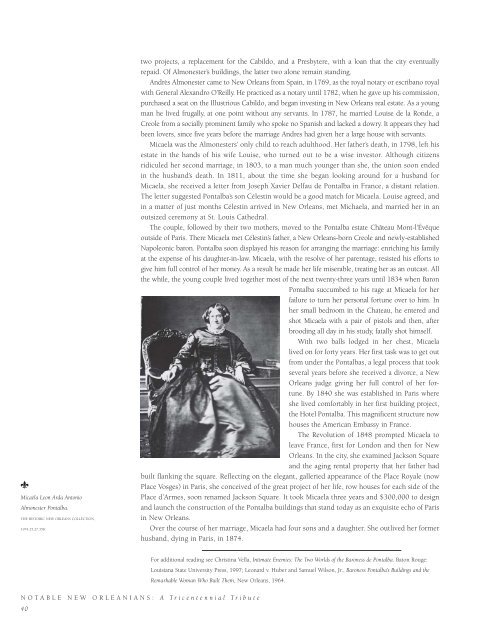Notable New Orleanians: A Tricentennial Tribute
An illustrated history of New Orleans paired with the histories of companies that have helped shape the city.
An illustrated history of New Orleans paired with the histories of companies that have helped shape the city.
Create successful ePaper yourself
Turn your PDF publications into a flip-book with our unique Google optimized e-Paper software.
Micaëla Leon Arda Antonio<br />
Almonester Pontalba.<br />
THE HISTORIC NEW ORLEANS COLLECTION,<br />
1974.25.27.358.<br />
two projects, a replacement for the Cabildo, and a Presbytere, with a loan that the city eventually<br />
repaid. Of Almonester’s buildings, the latter two alone remain standing.<br />
Andrès Almonester came to <strong>New</strong> Orleans from Spain, in 1769, as the royal notary or escribano royal<br />
with General Alexandro O’Reilly. He practiced as a notary until 1782, when he gave up his commission,<br />
purchased a seat on the Illustrious Cabildo, and began investing in <strong>New</strong> Orleans real estate. As a young<br />
man he lived frugally, at one point without any servants. In 1787, he married Louise de la Ronde, a<br />
Creole from a socially prominent family who spoke no Spanish and lacked a dowry. It appears they had<br />
been lovers, since five years before the marriage Andres had given her a large house with servants.<br />
Micaela was the Almonesters’ only child to reach adulthood. Her father’s death, in 1798, left his<br />
estate in the hands of his wife Louise, who turned out to be a wise investor. Although citizens<br />
ridiculed her second marriage, in 1803, to a man much younger than she, the union soon ended<br />
in the husband’s death. In 1811, about the time she began looking around for a husband for<br />
Micaela, she received a letter from Joseph Xavier Delfau de Pontalba in France, a distant relation.<br />
The letter suggested Pontalba’s son Célestin would be a good match for Micaela. Louise agreed, and<br />
in a matter of just months Célestin arrived in <strong>New</strong> Orleans, met Michaela, and married her in an<br />
outsized ceremony at St. Louis Cathedral.<br />
The couple, followed by their two mothers, moved to the Pontalba estate Château Mont-l’Évêque<br />
outside of Paris. There Micaela met Célestin’s father, a <strong>New</strong> Orleans-born Creole and newly-established<br />
Napoleonic baron. Pontalba soon displayed his reason for arranging the marriage: enriching his family<br />
at the expense of his daughter-in-law. Micaela, with the resolve of her parentage, resisted his efforts to<br />
give him full control of her money. As a result he made her life miserable, treating her as an outcast. All<br />
the while, the young couple lived together most of the next twenty-three years until 1834 when Baron<br />
Pontalba succumbed to his rage at Micaela for her<br />
failure to turn her personal fortune over to him. In<br />
her small bedroom in the Chateau, he entered and<br />
shot Micaela with a pair of pistols and then, after<br />
brooding all day in his study, fatally shot himself.<br />
With two balls lodged in her chest, Micaela<br />
lived on for forty years. Her first task was to get out<br />
from under the Pontalbas, a legal process that took<br />
several years before she received a divorce, a <strong>New</strong><br />
Orleans judge giving her full control of her fortune.<br />
By 1840 she was established in Paris where<br />
she lived comfortably in her first building project,<br />
the Hotel Pontalba. This magnificent structure now<br />
houses the American Embassy in France.<br />
The Revolution of 1848 prompted Micaela to<br />
leave France, first for London and then for <strong>New</strong><br />
Orleans. In the city, she examined Jackson Square<br />
and the aging rental property that her father had<br />
built flanking the square. Reflecting on the elegant, galleried appearance of the Place Royale (now<br />
Place Vosges) in Paris, she conceived of the great project of her life, row houses for each side of the<br />
Place d’Armes, soon renamed Jackson Square. It took Micaela three years and $300,000 to design<br />
and launch the construction of the Pontalba buildings that stand today as an exquisite echo of Paris<br />
in <strong>New</strong> Orleans.<br />
Over the course of her marriage, Micaela had four sons and a daughter. She outlived her former<br />
husband, dying in Paris, in 1874.<br />
For additional reading see Christina Vella, Intimate Enemies: The Two Worlds of the Baroness de Pontalba. Baton Rouge:<br />
Louisiana State University Press, 1997; Leonard v. Huber and Samuel Wilson, Jr., Baroness Pontalba’s Buildings and the<br />
Remarkable Woman Who Built Them, <strong>New</strong> Orleans, 1964.<br />
NOTABLE NEW ORLEANIANS: A <strong>Tricentennial</strong> <strong>Tribute</strong><br />
40
















